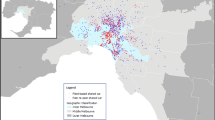Abstract
Information from various sources, but most specifically from the YORKSHARE car-sharing schemes, is brought together in an analysis of public reaction to, and participation in, a car-sharing scheme with centralised matching of applicants. The importance of various attributes of the sites, of the individuals and of the scheme organisation are assessed and conclusions are drawn.
The motivation of individual participants is analysed and is seen to vary from one person to another depending to some extent on their circumstances, but the universal importance of some features, notably cost savings, is revealed.
Similar content being viewed by others
References
Bonsall, P. W. (1980a). “A survey of attitudes to car sharing: a data base for microsimulation,” DoE, DTp, TRRL SR 563 Crowthorne.
Bonsall, P. W. (1980b). “Microsimulation of organised car sharing: description of the models and their calibration,” DoE, DTp, TRRL SR 564 Crowthorne.
Bonsall, P. W. (1980c). “Car sharing — where are we now? — a personal view,” Traffic Engineering and Control 21, 1, January.
Bonsall, P. W. (1981). “Car sharing in the United Kingdom — a policy appraisal,“ Journal of Transport Economics and Policy January.
Bonsall, P. W. and Spencer, A. H. (1981). A Comparison of Manual and Computerised Matching Procedures for Organised Car Sharing. University of Leeds, Institute for Transport Studies, TN 61.
Bonsall, P. W., Spencer, A. H. and Tang, W.-S. (1982). What Makes a Car Sharer — a Motivational Investigation. University of Leeds, Institute for Transport Studies, WP 158.
Bonsall, P. W., Spencer, A. H. and Tang, W.-S. (1983). “Performance and impact of organised car sharing schemes,” Transportation Research 17A,3. See also “ITS YORKSHARE, car sharing schemes in West Yorkshire,” Traffic Engineering and Control 22.1, January 1981.
Brunso, J. M. and Hartgen, D. T. (1980). An Evaluation of Employer-Based Car-Pool Coordinators as a Method of Increasing Ridesharing. New York State Department of Transportation, Planning Research Unit, Preliminary Research Report, 171.
Lewin, I. P. and Gray, M. J. (1979).“Evaluation of interpersonal influences in the formation and promotion of car pools,” Transportation Research Record 724: 35–39.
Margolin, J. B. and Misch, M. R. (1978). Incentives and Disincentives for Ridesharing: a Behavioural Study (Executive Summary). U.S. Department of Transportation, FHWA, Washington DC.
Spencer, A. H. (1980). Organised Car Sharing: The Use of the Unstructured Interview in Investigating the Factors Involved. University of Leeds, Institute for Transport Studies, TN 47.
Spencer, A. H. (1982). Perceptions of Incentives, Problems and Benefits of Car-Sharing Schemes. University of Leeds, Institute for Transport Studies, TN 93.
Author information
Authors and Affiliations
Rights and permissions
About this article
Cite this article
Bonsall, P.W., Spencer, A.H. & Tang, W.S. What makes a car-sharer?. Transportation 12, 117–145 (1984). https://doi.org/10.1007/BF00167372
Issue Date:
DOI: https://doi.org/10.1007/BF00167372




